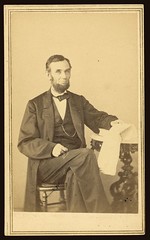How Can Libraries Help People Begin Research with Library Resources?
This is the second of several posts summarizing the more interesting or relevant sessions I attended at the Electronic Resources & Libraries conference.
In “The Problem of Where to Start,” Mike Buschman of Proquest discussed problems people encounter in the use of library e-resources and several approaches that libraries can use to help. These findings and recommendations were based on the results of research of academic researchers’ information-seeking behavior, which included, in part, studies described in the Ithaka Report.
Mike summarized the problem this way: researchers don’t know what library resources are available, have a hard time choosing which ones to use, and just don’t know where to start. As a result, they usually don’t begin their research with library resources. At the same time, they still trust libraries and think that the content they offer is more credible than general Web resources. To preserve their role in the research process, Mike indicated that libraries need to provide training in information literacy, market their resources, place access points in context, and use a “unified discovery” service.
Now came what ended up being the primary focus of the session – a description of Summon, a unified discovery tool under development at Serials Solutions. Unlike federated search products, which send user queries out to different databases, Summon indexes library resources from Summon partners (like EBSCO, OCLC and Elsevier) and subscribing libraries (our OPACs for example). A user initiating a search from a library website through Summon can search the index, review relevant results, and access resources in the library’s knowledge base through a single interface. Because one index is searched, some of the problems typically encountered with federated search (such as speed) should be improved.
But Summon may not tackle all problems users face. One of the session attendees, for example, pointed out that the different indexed resources will use different subject taxonomies. And at this point, I think I recall Mike saying that Summon’s index doesn’t include terms found in the entire article text. The response of session attendees was very positive, but a little guarded.
Mike indicated that Summon should become commercially available this summer. People asked about cost. Mike replied that economies of scale should make Summon affordable. I hope so, for libraries of many shapes and sizes.
Here are links to a recent articles on Summon in Library Journal and Information Today. The latter article indicates that the primary target market for Summon is academic libraries and that Summon does not “know enough yet about other libraries.”
--Katie Fearer
In “The Problem of Where to Start,” Mike Buschman of Proquest discussed problems people encounter in the use of library e-resources and several approaches that libraries can use to help. These findings and recommendations were based on the results of research of academic researchers’ information-seeking behavior, which included, in part, studies described in the Ithaka Report.
Mike summarized the problem this way: researchers don’t know what library resources are available, have a hard time choosing which ones to use, and just don’t know where to start. As a result, they usually don’t begin their research with library resources. At the same time, they still trust libraries and think that the content they offer is more credible than general Web resources. To preserve their role in the research process, Mike indicated that libraries need to provide training in information literacy, market their resources, place access points in context, and use a “unified discovery” service.
Now came what ended up being the primary focus of the session – a description of Summon, a unified discovery tool under development at Serials Solutions. Unlike federated search products, which send user queries out to different databases, Summon indexes library resources from Summon partners (like EBSCO, OCLC and Elsevier) and subscribing libraries (our OPACs for example). A user initiating a search from a library website through Summon can search the index, review relevant results, and access resources in the library’s knowledge base through a single interface. Because one index is searched, some of the problems typically encountered with federated search (such as speed) should be improved.
But Summon may not tackle all problems users face. One of the session attendees, for example, pointed out that the different indexed resources will use different subject taxonomies. And at this point, I think I recall Mike saying that Summon’s index doesn’t include terms found in the entire article text. The response of session attendees was very positive, but a little guarded.
Mike indicated that Summon should become commercially available this summer. People asked about cost. Mike replied that economies of scale should make Summon affordable. I hope so, for libraries of many shapes and sizes.
Here are links to a recent articles on Summon in Library Journal and Information Today. The latter article indicates that the primary target market for Summon is academic libraries and that Summon does not “know enough yet about other libraries.”
--Katie Fearer
Labels: databases, libraries, resources, technology


